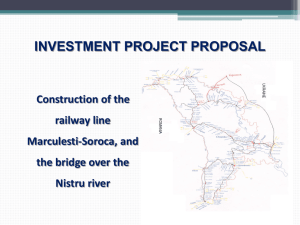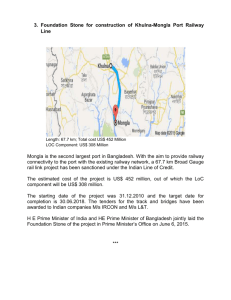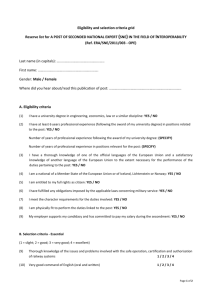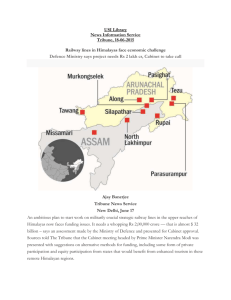Hutter Dóra Keywords: brownfield, railway rust areas, urban green
advertisement
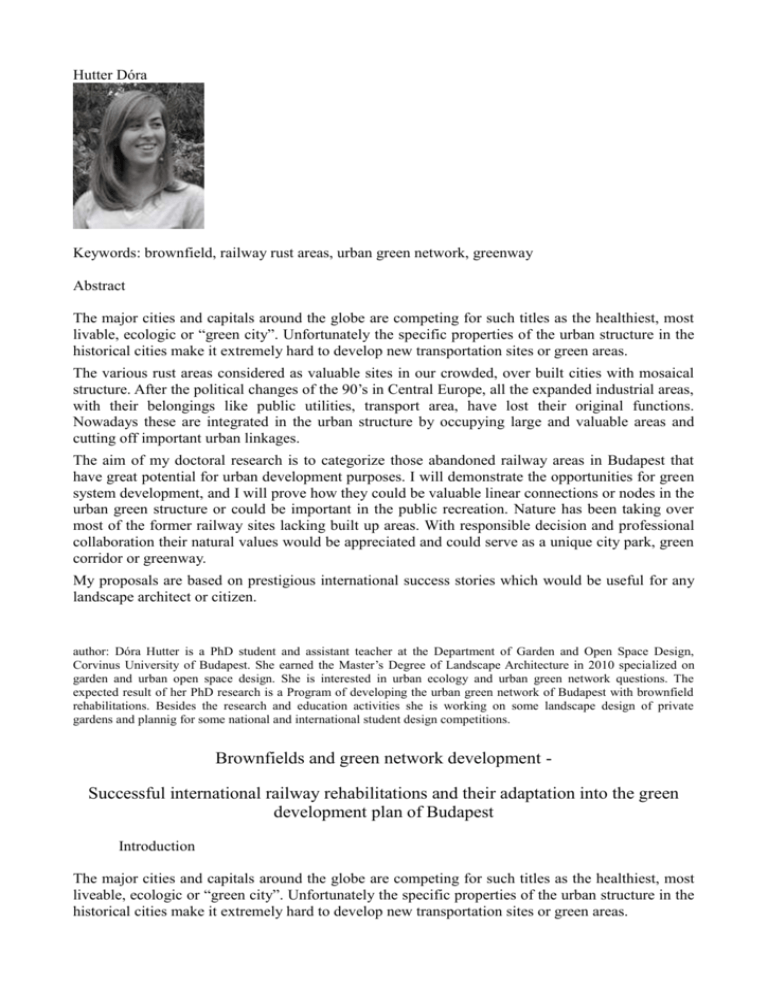
Hutter Dóra Keywords: brownfield, railway rust areas, urban green network, greenway Abstract The major cities and capitals around the globe are competing for such titles as the healthiest, most livable, ecologic or “green city”. Unfortunately the specific properties of the urban structure in the historical cities make it extremely hard to develop new transportation sites or green areas. The various rust areas considered as valuable sites in our crowded, over built cities with mosaical structure. After the political changes of the 90’s in Central Europe, all the expanded industrial areas, with their belongings like public utilities, transport area, have lost their original functions. Nowadays these are integrated in the urban structure by occupying large and valuable areas and cutting off important urban linkages. The aim of my doctoral research is to categorize those abandoned railway areas in Budapest that have great potential for urban development purposes. I will demonstrate the opportunities for green system development, and I will prove how they could be valuable linear connections or nodes in the urban green structure or could be important in the public recreation. Nature has been taking over most of the former railway sites lacking built up areas. With responsible decision and professional collaboration their natural values would be appreciated and could serve as a unique city park, green corridor or greenway. My proposals are based on prestigious international success stories which would be useful for any landscape architect or citizen. author: Dóra Hutter is a PhD student and assistant teacher at the Department of Garden and Open Space Design, Corvinus University of Budapest. She earned the Master’s Degree of Landscape Architecture in 2010 specialized on garden and urban open space design. She is interested in urban ecology and urban green network questions. The expected result of her PhD research is a Program of developing the urban green network of Budapest with brownfield rehabilitations. Besides the research and education activities she is working on some landscape design of private gardens and plannig for some national and international student design competitions. Brownfields and green network development Successful international railway rehabilitations and their adaptation into the green development plan of Budapest Introduction The major cities and capitals around the globe are competing for such titles as the healthiest, most liveable, ecologic or “green city”. Unfortunately the specific properties of the urban structure in the historical cities make it extremely hard to develop new transportation sites or green areas. The various rust areas considered as valuable sites in our crowded, over built cities with mosaical structure. Terminology The term brown field was first mentioned in the American terminology and firstly it only meant the abandoned industrial areas. Since then it gained new meanings and several different definitions were published. There are certain publications that merely focus on the terminology itself, but without giving any final classification. Having said that, in this article I will use the following definitions, which are based on the common terminology of the Hungarian research studies1: Brownfield area: - it is usually classified as an area that fully or partly lost its function, underutilized and abandoned - former industrial or military areas, with their transportation facilities - might have real or perceived contamination problems - another problematic factor is the unsettled proprietary relations and legal regulation and the numerous small real estates. Brown zone: The above specified brown areas together form a brown zone. The main industrial areas that involve the industrial, transportational, residential areas with green sites. More than 13% (68km2) of the administrative boundary of Budapest is considered a brown zone, while if we compare it to the built-up area it is 30%.2 Within a few areas the rehabilitation process has already started, or has already been completed, so the real problem is the so called: rust belt. Rust belt: From my point of view the most interesting areas located within the rust belt. It consist of the unused and abandoned industrial sites - with the former facilities or transport areas - that fully lost their functions, and it is unlikely to be restored. The ruins of the railway system Transport as part of the infrastructure generates development in a city. It provides public transport, logistics, and creates military and communicational possibilities, resulting a constant growth in the population and urban area. From the second half of the XIX century one of the most significant elements in the urban structure development was the railway. There is a strong relation between the development of the industrial - economical sectors (resulting the current brownfield areas) and the railway network. I researched the development of the railway network, its function in the urban structure, the reduced importance and I was focusing on those areas that: 1. are underutilised or totally abandoned 2. are not involved in the development of MAV (Hungarian State Railways ) 3. can be integrated into the urban structure due to their size or location Based on these aspects I have prepared the cadastral map of the railway rust areas in Budapest. In this study I will introduce the possible ideas for their development. Therefore I have also defined a 4th category which includes those areas that: 1 Barta Györgyi. (editor): A budapesti barnaövezet megújulási esélyei. Budapest, MTA, 2004 Beluszky Pál, Győri Róbert: A budapesti barnaövezet határai. In: Barta Györyi. (autor): A budapesti barnaövezet megújulási esélyei. Budapest, MTA, 2004. 71-74.p 2 4. have great potential in the green area development due to their size or location (figure 1) First of all I would like to emphasise that a brown area rehabilitation can be favourable even though if it is not a green area or green surface oriented. Any brownfield development would result renewed buildings, environment or open spaces, a better ambiance and biologically active surface rate, or reduce the urban heat-island phenomenon. All in all it is beneficial in the aspect of the urban ecology. But based on the current extremely low green space coverage per inhabitant in Budapest, during such development we should attempt to keep then raise the biologically active surface rate of the examined areas. Moreover we should also promote its integration to the recreational network. A well-functioning network which opens up the entire urban structure is well established if the nodes consist of areal elements and connected by lineal segments. In the next table I have collected a few components divided in two groups: the railway and the green infrastructure: (table 1) By transforming a few abandoned elements of the complex railway network (making use of their original structural properties) we can fill in the holes of the green system. Creating the lack of linear and nodal units can strengthen the functionality of the urban green network. Case studies The national and international examples of successful brownfield projects such as tematical public parks, institution gardens, linear green network elements with their unique features, can be very attractive for the local community and even for tourists. Being new recreational areas, green network or conditioning elements they are significant components of the green area network of the settlements. I will present and introduce international examples of such successful rehabilitations, and developments which will demonstrate: How can we create numerous green elements through brownfield rehabilitations? And moreover how we could also grow the green surface on the railway ruins. Petite Centuire, Paris Paris is famous for its grandiose architecture, urban restructuring and reforms and railway network. In 1852 they opened the 32km long railway ring that connected the most important elements of the railway. But after a few decades it became underutilised, by 1934 it was abandoned, and during the past 80 years it was exposed to the natural forces. In the last year various rehabilitation ideas of the different sections such as a new tram line or for example a green way.3 (photo 1) Le Sentier Nature, Paris One of the most interesting low-cost ecological rehabilitation project of the Petite Centuire was the Le Sentier Nature. Between two old stations a 1, 5 km long greenway was opened in 2007. It is a simple walkway in a green corridor with mulch path. The aim of the project is to protect and to exhibit the spontaneous vegetation and to make a new, unique recreational place in the overbuilt city. It is a nature reserve and serves as an educational path. It introduces various vegetation types along the trail and includes many interesting railway rules such as: trails, stone walls, fences, crushed stones.4 (photo 2 ) 3 http://petiteceinture.blogspot.hu/ http://www.paris.fr/pratique/paris-au-vert/balades-au-vert/decouvrir-les-richesses-de-la-petiteceinture/rub_9660_stand_53584_port_23803 http://www.v2asp.paris.fr/commun/v2asp/v2/environnement/baladepc16/index.html 4 Promenad de Plantée, Paris A more complex and well known urban project is the Promenad de Plantée. There was an old rail way trail from the Bastille (city centre) to the Petite Centuire (rail way ring on the periphery) which has been abandoned since 1969. In 1993 a new, 4, 7 km long promenade was opened, which is the first green way on an elevated rail road. As it was converted from a railway trail, the path line is diverse it goes into tunnels, through cuttings and over embankments or viaducts. There are a lot of viewpoints to the boulevard and squares. The almost 5 km long way connects numerous passages, public squares, parks and gardens. This project had a very different goal: to make a social, economic, aesthetic improvement in the low-prestige district through open space and green area development. One of its featured element the Viaduc des Arts became a real tourist attraction which proves that their original plan has been achieved.5 (photo 3) Rails - to - Trails, Washington D.C The rail trail idea is a well-known term in the USA which means the conversation of a disused railway into a multi-use path, typically for walking, cycling and sometimes horse riding. Rails-to-Trails Conservancy is a non-profit organization based in Washington, whose mission is to create a nationwide network of trails from former rail lines and connecting corridors to build healthier places for healthier people. Nowadays it has more than 150.000 members and supporters, nearly 20.000 miles of rail-trail and more than 9.000 miles of potential rail-trails are waiting to be built.6 (photo 4) High Line, New York An elevated railroad was built in the industrial district of the western side of Manhattan but it was closed in 1930. A community-based non-profit group was formed in 1999 to create an elevated public green area. Friends of the High Line, the design team and politicians were working together. Firstly they made a serious marketing strategy with spectacular press and design documentation. The first section of the elevated linear park was opened in 2009. By today there are a lot of books, articles, souvenirs and it is not the first, but one of the most famous brownfield rehabilitation in the world. The line runs 30 feet (9 meter) above the streets therefore many stairs and elevators connect the path and the street level. A really unique and modern open space network has been created with viewpoints, public terraces and green elements. The design team mostly protected the spontaneous vegetation, but they also rose up the biological vegetation index with more extensive and intensive green surfaces and built in sprinkler system which is helping the initial growth of plants.7 (photo 5) Gleisdreieck, Berlin It was a transit station which was abandoned after the II. World War. A spontaneous vegetation spread out (with more species than in the Tiergarten) adds a great value to the city. The first part of the huge public park on 17 acres was opened in 2011, and the other 9 acres in last year. The new public park is located in the city centre, it has good access to 3 metro stations, an S-bahn station and the bicycle line. It is a very popular recreational area with multiple functions: playground, sport fields, cross and extreme field, running path, tribune, retreat places and community gardens. The different functional areas have unique types of vegetation: forest with bushes, parkland, huge lawn, gravel with trees etc. … The park was built in the minimal design style, the furniture and pavements 5 www.promenade-plantee.org 6 http://www.railstotrails.org/ 7 http://www.thehighline.org/ have really clean lines of grand elements, and the materials include: concrete, gravel, iron and wood. It is very luminous, tidy and elegant.8 (photo 6) Natur-Park Schöneberger Südgelände, Berlin It is also a rehabilitation of a transit station. As it was an external transfer station in Berlin this site is not in the city centre. The aim of the project was similar to the path of Paris: to protect and exhibit the spontaneous vegetation and create a natur park! It is not only a greenway, but there is also a large area with a lot of railway ruins. It opens up a long path which was built in the forest and runs half meter above the ground. From the path and from the few view towers we can observe the vegetation its original condition.9 (photo 7) Parc de Bercy, Paris This is a 14 acres public park along the Seine River, in the east part of Paris with more brownfield memories. The park was created in the middle of 1990s as part of a project the aim of which was to revitalise an abandoned warehouse area. The external side of the site has a width wall (with a roof garden) which protects it from the noisy traffic areas. Parc de Bercy has 3 sections with different garden styles and functions. The ‘Romantic Garden’ includes fishponds and dunes, the ‘Formal Gardens’ dedicated to plant life and the ‘Great prarie’ is an area of open lawns and sport fields shaded by tall trees. This park is one of the most frequented and beloved modern city parks in Paris incorporating some institutions as well. There are museums, a sport arena and it is connected by a footbridge with the other part of the Seine where the new National Biblioteche was opened with an elegant public square.10 (photo 8) Parc Chemin du L’Ile, Nanterre - Paris This site is located in a degraded brownfield zone within the suburban area of Paris, surrounded by a highway interchange, train lines, the Seine river, a papermaking factory and penitentiary with new business and residential areas. This public park project from 2006 is a part of the long rehabilitation intervention on the urban spaces linking of the La Defense (the mostly modern business) district of Paris. At the entrance of the park a sequence of ponds pump the water from the Seine then filter and store it to be used in the sprinkler system. On 14, 5 acres the park has many scenic seating areas including benches or lawn sites to relax and enjoy the surrounding riverside landscape.11 (photo 9) Result and conclusion These representative international examples show and demonstrate how could another city in similar condition develop a remarkable urban green structure items from an abandoned railway sites. Than I would like to review the potential railway rust areas of the Hungarian capital. Based on the previously described 4 categories I have chosen more than 20 different sites, that are significant from the urban ecological aspect. (figure 2) 8 9 10 11 http://www.gruen-berlin.de/parks-gaerten/park-am-gleisdreieck/ http://gleisdreieck-blog.de/ http://www.gruen-berlin.de/parks-gaerten/natur-park-suedgelaende/ http://www.aviewoncities.com/paris/parcdebercy.htm http://en.wikipedia.org/wiki/Parc_de_Bercy http://promenades.hauts-de-seine.net/parc-chemin-ile I have divided the most potential sites into different groups based on their potential land-use categories. I highlighted those potential areas that have similar characteristics with the previously introduced international examples, and we can see that by transforming how could play a vital role in an optimal urban green structure and green network. (table 2) The last schematic plans represent how could the new units (with light green colours) are helping the current network (with dark green colour), and how an optimal green system would be like one day. Transforming the rust areas could result in numerous new axises with narrow greenways, width green corridors and really important green areas in the nodes. Finally in the right side map I would like to demonstrate through conscious and long term planning we could create such a radial and ring like green structure. (figure 3)


